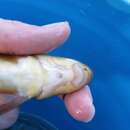Columbia River Demersal Habitat
provided by EOL authors
This taxon is one of a number of demersal species in the Columbia River system. Demersal river fish are found at the river bottom, feeding on benthos and zooplankton. The Columbia River is the largest North American watercourse by volume that discharges to the Pacific Ocean. With headwaters at Columbia Lake, in Canadian British Columbia, the course of the river has a length of approximately 2000 kilometers and a drainage basin that includes most of the land area of Washington, Oregon and Idaho as well as parts of four other U.S. states and two Canadian provinces. The Columbia River Basin of northwestern North America is an important habitat for Acipenser transmontanus. The Columbia River is the largest North American watercourse by volume that discharges to the Pacific Ocean. With headwaters at Columbia Lake, in Canadian British Columbia, the course of the river has a length of approximately 2000 kilometers and a drainage basin that includes most of the land area of Washington, Oregon and Idaho as well as parts of four other U.S. states and two Canadian provinces. The hydrology and aquatic habitat of the Columbia River basin has been adversely altered by numerous large dams. There are over 250 reservoirs and around 150 hydroelectric projects in the basin, including 18 mainstem dams on the Columbia and its main tributary, the Snake River. Water quality in the Columbia River has deteriorated over the last century, due to agricultural runoff and logging practices, as well as water diversions that tend to concentrate pollutants in the reduced water volume. For example nitrate levels in the Columbia generally tripled in the period from the mid 1960s to the mid 1980s, increasing from a typical level of one to three milligrams per liter. Considerable loading of herbicides and pesticides also has occurred over the last 70 years, chiefly due to agricultural land conversion and emphasis upon maximizing crop yields. Heavy metal concentrations in sediment and in fish tissue had become an issue in the latter half of the twentieth century; however, considerable progress has been made beginning in the 1980s with implementation of provisions of the U.S.Clean Water Act, involving attention to smelter and paper mill discharges along the Columbia. Some large demersal fish species occurring in the Columbia Basin are the 610 centimeter (cm) white sturgeon (Acipenser transmontanus), the 76 cm Pacific lamprey (Lampetra tridentata); the 55 cm Brown bullhead (Ameiurus nebolosus); the 61 cm largescale sucker (Catostomus macrocheilus); the 64 cm longnose sucker (Catostomus catostomus catostomus); and the 65 cm Utah sucker (Catostomus ardens).

